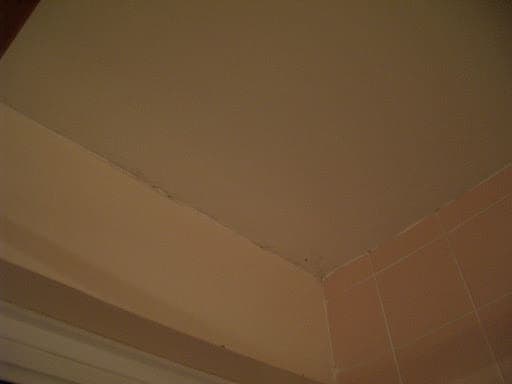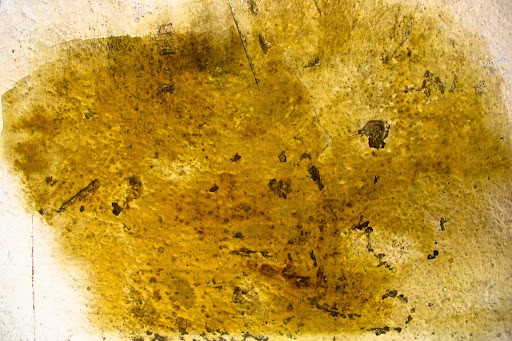Spray the ceiling with washing detergent. Let it sit for around an hour, then scrub it with a sponge and rub it dry with a cloth once you are done.
If you have yellow stains on the bathroom ceiling, it is important to determine the cause of these stains as quickly as possible.
This is because some yellow stains in the bathroom are there due to water damage, which could mean that mold is present.
In areas where there is a good chance of leaking pipes, high humidity, or other forms of moisture buildup inside your home, you may see these yellow spots on the ceilings or walls.
This can be from several common sources.
This article will explore the different causes of yellow stains in the bathroom and find out how to clean or treat each one.

1. Yellow Mold
While you may expect household mold to be black or dark brown, yellow mold is also common. Mold can be easily detected due to its leathery or fuzzy look.
This is especially common in the bathroom because of the high humidity. If the bathroom is not well-ventilated, hot steam from the shower can accumulate in the room and cause mold to grow.
Mold growth is the most urgent stain to deal with because it can be very dangerous to the health of both humans and animals who live in the household.
If you find the yellow stains on the bathroom ceiling to be mold, immediate action should be taken to remove them.
It is also a good idea to use a dehumidifier or open windows and a fan to reduce the humidity in the room so that more mold does not grow back.
How To Clean Yellow Mold – Dish Detergent Mixture
Anytime you work to remove mold from your home, you should be wearing a mask and gloves, and in some cases, full coveralls and a respirator should be worn.
If mold spores get into your lungs or sinuses, it can cause very serious illnesses, according to the United States Centers for Disease Control (USCDC).
When simply removing yellow mold spots where significant mold has not yet formed, the mask and gloves should be enough protection.
There are a few ways to clean an area where yellow spots from mold growth have been found.
The first one is a dish detergent solution.
Materials
- Dish detergent
- Water
- Funnel
- Empty spray bottle
- Gloves
- Mask
- Sponge
- Damp rag
Instructions
- Put on the mask and gloves.
- Mix the water and dish detergent as you would wash a sink full of dishes.
- Funnel the dish detergent solution into the empty spray bottle.
- Spray the affected area with the soap solution.
- Allow the sprayed area to sit for 10 or 15 minutes.
- Using a sponge, scrub the area to remove the yellow spots of mold growth.
- Wipe the area clean with a damp rag.
- Set up dehumidifiers or open windows and a fan until the room is totally dry.
- Check periodically to ensure that the mold is not growing back.
Cleaning Yellow Mold – Bleach Solution
If mold continues to be an issue, you might want to try the second way to clean mold-related yellow spots on the ceiling in the bathroom; with a bleach solution.
Once you have completed the method above, you will need to take further steps.
What You’ll Need
- One cup of bleach
- Three cups of water
- Funnel
- Empty spray bottle
- Sponge
- Damp cloth
Instructions
- While still wearing the gloves and mask you put on to wash with the dish soap solution, mix one cup of bleach into three cups of water.
- Funnel this mixture into an empty spray bottle and spray the affected area with the bleach mixture.
- Allow the beach mixture to set on the mold-infested area for an hour.
- Scrub again with a sponge, and then wipe down with a damp cloth.
- Again, you might want to set up dehumidifiers or fans and open windows to lower the room’s humidity and prevent further growth.
2. Yellow Nicotine Stains
If the yellow spots on your bathroom ceiling or walls are caused by nicotine from cigarette smoking, cleaning them will be more time-consuming and complicated.
In such cases, the staining goes beyond a few spots and is spread on the entire surface of the walls and ceilings.
There are a couple of ways to deal with this type of stain. If the stains affect the entire room, there are a few steps to take before you begin to perform any of these cleaning methods.
- Remove any pictures, fixtures, etc., from the walls.
- Remove outlet covers, vent covers, light switches, etc.
- If the nicotine stain has thickened, remove as much of it as possible with a paint scraper.
- Proceed to the next steps in the process that you choose from below.
Removing Nicotine Stains With Dish Soap And Baking Soda
A mixture of dish soap and baking soda is a good start for cleaning yellow nicotine stains off the bathroom ceilings and walls.
Materials
- Three tablespoons of dish soap
- Half a cup of baking soda
- One gallon of hot water
- Bucket
- Sponges
- Dry cloths
Instructions
- In a bucket, mix one gallon of hot water, half a cup of baking soda, and three tablespoons of dish soap.
- Dip a sponge into this solution, squeeze out the excess liquid, and scrub the walls with the sponge.
- Rub the cloth in circular motions, working on small areas.
- Dry each area with the dry cloths before moving on to the next to avoid saturating the drywall.
- Rinse the sponge between each section in clear water and wring as dry as possible before dipping it back into the cleaning solution.
- Continue until all stained areas have been scrubbed.
Using Lemon Juice Or Vinegar To Remove Yellow Nicotine Stains
You can also use undiluted lemon juice or vinegar to remove nicotine stains from the walls or ceiling.
Materials
- Protective gloves and eyewear
- Undiluted lemon juice, white vinegar, or apple cider vinegar
- Empty spray bottle
- Sponges
- Dry cloths
Instructions
- Put on the protective gear and open windows or use a fan for ventilation.
- Pour the undiluted lemon juice or vinegar into the empty spray bottle.
- Spray the solution over small parts of the stain at a time.
- Scrub the sprayed walls with the sponge.
- Work in small sections, scrubbing in circular motions.
- Rinse the sponge, wring it out, and wipe the walls with clean water after scrubbing, moving in one section at a time.
- Use the dry cloth to wipe down the walls before moving to another section.
3. Yellow Stains On The Ceiling From Water Damage

Yellow stains that have formed on the bathroom ceiling as the result of a water leak or water damage will often form a yellow halo.
If left there for lengthy periods of time, this halo will become darker and may eventually look brown.
You might also notice a yellow stain coming through the paint.
Additional Tips You Should Know
- If the yellow stains on the bathroom ceiling or the walls in your home are from water damage, you may need to call in a professional to track down and repair any water leaks that you might have.
- This could be from leaky pipes or a leak in the roof. Fixing the stain before the leak has been repaired will only return the stain.
- The walls or ceiling will need to be treated with a stain-blocking primer and then painted to fix such a stain.
If you know how to prepare, sand, treat and paint a room yourself, you may choose to do so.
- You can also call in professional painters to handle the job. They should be aware that bathroom paints are specifically designed to repel moisture.
FAQs On Yellow Spots On The Bathroom Ceiling
What If There Are Yellow Stains Inside Of My Shower?
Yellow stains inside the shower are often caused by water with a yellow tint. This is from natural, organic tannins in the water. Mixing baking soda and undiluted vinegar can form a paste that may help clean these stains.
How Can I Tell If A Stain Is Mold Or Mildew?
Mold stains usually have more texture and can be leathery or fuzzy. Mildew stains are usually flat.
Are There Other Ways To Tell If I Have Water Damage?
Aside from yellow, brown, or even black stains on your ceiling or walls, you should also look for peeling paint, bubbling on the walls, sagging the ceiling, or bulging in the walls.